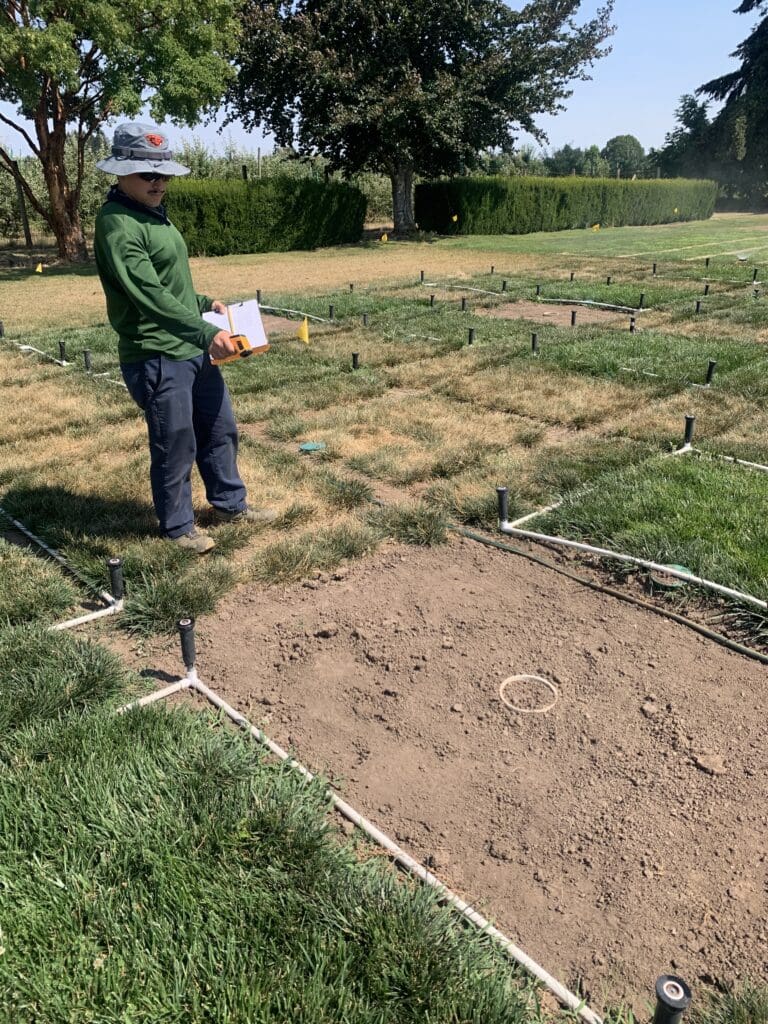
Photo: Alec Kowalewski
Written by: Alec Kowalewski, associate professor and turfgrass specialist at Oregon State University
Turfgrass is known for requiring frequent irrigation during the summer months to sustain active growth and development, and an aesthetically pleasing appearance. Due to recent concerns associated with the availability of water, turfgrass irrigation is being scrutinized.
Turfgrass scientists have been exploring the use of genera, species and cultivars with improved drought tolerance and reduced water use requirements. In the northern parts of the U.S., cool-season grasses like tall fescue and fine fescue have emerged as genera that require less water. Some landscape managers and homeowners have even decided to discontinue summer irrigation of drought-tolerant grasses such as these as a method to further conserve water. In this circumstance, cool-season turfgrass will go into a state of summer dormancy during periods of extended drought and heat stress, returning to active growth and development when rains return and temperatures decrease. Others have even removed their lawns in exchange for bare soil, mulch or hardscape.
However, recent research conducted at Oregon State University in Corvallis, Oregon, has shown that by not irrigating your lawn, you compromise several of the ecosystem services the turfgrass would otherwise provide. These ecosystem services include heat island effect and carbon sequestration.
Preliminary research findings determined that the average summer surface temperature of irrigated turfgrass in June, July and August in Western Oregon was 85 F, while the non-irrigated turfgrass summer temperature averaged 99 F, and bare soil averaged 115 F. In fact, bare soil reached temperatures as high as 132 F in August, while turfgrass irrigated four times per week was 92 F (40 degrees cooler).
In fact, more frequently irrigated turfgrass resulted in cooler surfaces than infrequently irrigated turfgrass. Considering this, I would suggest taking the amount of water you intend to apply in a week (1” for example) and dividing it into 4 applications (0.25” per application x 4 applications per week = 1” of weekly water) to provide the optimum mitigation of heat islands effects.

In addition to changes in surface temperature, major differences in carbon sequestration have been observed between irrigated turfgrass, non-irrigated turfgrass and areas where the turfgrass was removed. Preliminary results have found that cool-season turfgrass is a carbon sink during periods of cool, wet weather without irrigation, which is from October to the subsequent June (9 months per year) in Western Oregon.
Areas that had turfgrass removed became a carbon source, rather than sink, meaning the carbon sequestered in the soil by the turfgrass roots is now being lost to the atmosphere by decomposition because the turfgrass is no longer a living system. During the summer months when irrigation is required in Western Oregon (July, August, and September), non-irrigated turfgrass transitioned from being a carbon sink to a carbon source. However, the irrigated turfgrass was able to continue sequestering carbon during the summer months due to the sustained active growth and development.
For those who want to provide the benefits of reduced heat island effect and sustained summer carbon sequestration while reducing potable water use, the use of effluent water from kitchens, washing machines, dishwashers, sinks, showers, etc. is an option. The use of effluent water has been increasing in popularity and government mandates in arid areas of the country, which are typically dominated by warm-season turfgrass. Therefore, the effluent irrigation work conducted on cool-season turfgrass is minimal.
However, recent research on cool-season turfgrass at Oregon State University has determined that effluent water with high concentrations of the typical household byproducts and cleaning agents [boron (B), sodium (Na), and chlorine (Cl)] did not substantially reduce cool-season turfgrass quality, growth and development and can safely be used for irrigation. This research did not see a substantial increase in soil levels of B, Na and Cl likely because the annual precipitation in cool, humid environments like Western Oregon is adequate to flush these elements during the fall, winter and spring months.
In the future, humans will have to continue to search for innovative methods to conserve water. Discontinuing summer irrigation of turfgrass is an option for conserving water, but this will compromise the ecosystem services that have made irrigated turfgrass a popular choice, aesthetic appeal, reduced heat island effects, and enhanced carbon sequestration.
As an alternative to discontinued irrigation, effluent water use is a viable option for cool-season, and warm-season turfgrass. If you want to maximize the cooling effects and carbon sequestration associated with turfgrass, frequent irrigation (four times per week) was found to be optimal. To conserve water when applying frequent irrigation reduced application rates are suggested. Considering this 0.25” applied four times per week totaling 1” per week is suggested for cool-season turf in northern climates like Western Oregon.

